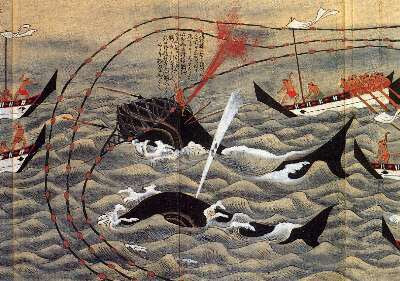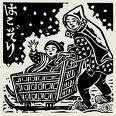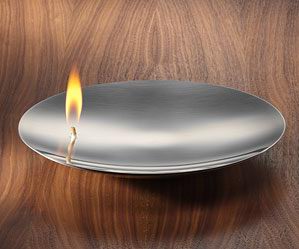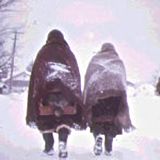::::::::::::::::::::::::::::::::::::::::::::::::::::::::::::::::::::::::::::::::::::::::::::::::::::
Hunting in all seasons
***** Location: Japan
***** Season: Various, see below.
***** Category: Humanity
*****************************
Explanation
Hunters living in the large forests of Japan are out in winter to get some food.
Bears, wild boars, deer and fowl. Dogs are used for hunting.
Usually they go in groups and share the food.
The official hunting season is from 15th of November to the 15th of February next year.
In Hokkaido it is from the first of October till 30th of January.

:::::::::::::::::::::::::::::::::::::::::::::::::::::::::::::::::::::::::::::::::::::::::::::::::::
Kigo for mid-winter
nagashimochi 流黐 (ながしもち) luring waterfowl
mochi nagachi 黐流し(もちながし
Long branches were covered with birdlime to go after ducks and other waterfowl.
:::::::::::::::::::::::::::::::::::::::::::::::::::::::::::::::::::::::::::::::::::::::::::::::::::
Kigo for all winter
kari 狩 (かり) hunting
ryooki 猟期(りょうき)hunting season
kariba 狩場(かりば)hunting ground
ryoojin 猟人(りょうじん)hunter
... karyuudo 狩人(かりゅうど)
... satsuo 猟夫(さつお)
ryooken 猟犬(りょうけん)hunting dog, hound
ryoojuu 猟銃(りょうじゅう)hunting rifle, shotgun
kemonogari 獣狩(けものがり)hunting wild animals
shishigari 猪狩(ししがり) hunting wild boars, boar-hunting
shikagari 鹿狩(しかがり)deer-hunting
seiko 勢子(せこ)beater
They make a lot of noise to drive the animals toward the hunters.
yokohiki 夜興引(よこひき)(yogohikiよごひき) hunting at night
... yohiki 夜引(よひき)
Usually with dogs to lead the way in a mountain forest on a snowy night.
.................................................................................
.................................................................................
itachi wana 鼬罠 (いたちわな) trap for a weasel
weasel, itachi 鼬、イタチ
.................................................................................
kitsune wana 狐罠 (きつねわな) trap for fox hunting
... kitsune otoshi 狐落し(きつねおとし)
kitsune tsuri 狐釣(きつねつり)hunting for foxes
.................................................................................
kumamatsuki 熊突 (くまつき) hunting for bears
... kumagari 熊狩(くまがり)
... kumaryoo 熊猟(くまりょう)
anaguma uchi 穴熊打(あなぐまうち)driving the bear out of his hole
.................................................................................
usagigari 兎狩 (うさぎがり) rabbit-hunting
usagi ami 兎網(うさぎあみ) net for hunting rabbits
usagi wana 兎罠(うさぎわな)trap for hunting rabbits
.................................................................................
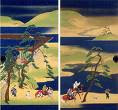
takagari 鷹狩 (たかがり) hunting with hawks and falcons falconry
... hooyoo 放鷹(ほうよう)
takano 鷹野(たかの)open field with hawks
takajoo 鷹匠 (たかじょう) keeper, trainer of the falcons and hawks
... takashi 鷹師(たかし)
Falkner, Beizjäger
Hunting with hawks and falcons was a privilege of many lords, who kept their own hawks. Training a falcon was done in spring (see below). There are two ways to train them, one if the animals have only to recognize their own master.
The other to train them to recognize another person, if they were trained for the hunting expeditions of the local lord or daimyo.
Daimyo Falconry is now sometimes shown in Hamarikyu Park in Tokyo.
Hawk (taka 鷹 たか)
. takagari 鷹狩り hunting with hawks and falcons .
The hunting grounds of the Shoguns in Edo
.................................................................................
tanukigari 狸狩(たぬきがり)badger-hunting
tanuki wana 狸罠 (たぬきわな) trap for hunting badgers
. WASHOKU
Tanukijiru 狸汁 (たぬきじる) Badgers' soup
:::::::::::::::::::::::::::::::::::::::::::::::::::::::::::::::::::::::::::::::::::::::::::::::::::::
:::::::::::::::::::::::::::::::::::::::::::::::::::::::::::::::::::::::::::::::::::::::::::::::::::::
Hunting in Spring
kigo for all spring
torimochi ajiro 鳥持網代 ( とりもちあじろ)
hunting fish in traps with the help of water fowl
ikariryoo, ikari ryoo いかり漁(いかりょう)
Fishing KIGO in all seasons
................................................................................
kigo for late spring
naitogari 鳴鳥狩 ないとがり hunting with hawks
falcons and falconry
asa takagari 朝鷹狩(あさたかがり)
asatogari 朝鳥狩(あさとがり)、
oboegari 覚狩(おぼえがり)training the hawk
tomarigari 泊り狩(とまりがり)staying in the mountain (hut for training)
tomariyama, tomari-yama 泊り山(とまりやま)
kikisuedori 聞すえ鳥(ききすえどり)
misuedori 見すえ鳥(みすえどり)
suzuko 鈴子(すずこ) little bell
suzuko sasu taka 鈴子挿す鷹(すずこさすたか)
tsugi ootaka 継尾の鷹(つぎおのたか)
shirao no taka 白尾の鷹(しらおのたか)hawk with a white tail
shirafu no taka 白斑の鷹(しらふのたか)hawk with white spots
Hunting with hawks is done in winter, but the training of the animals starts in spring. They get a bell on one foot and have to learn how to hunt and come back to the master. Often the hawker and his animal stay in a mountain hut for a while together during this time.
................................................................................
kigo for late spring
ryooki owaru 猟期終る (りょうきおわる)
end of the hunting season
ryoo nagori 猟名残(りょうなごり)after the hunting season
..... nagori no ryoo 名残の猟(なごりのりょう)
juuryoo teishi 銃猟停止(じゅうりょうていし)end of rifles and hunting
:::::::::::::::::::::::::::::::::::::::::::::::::::::::::::::::::::::::::::::::::::::::::::::::::::::
:::::::::::::::::::::::::::::::::::::::::::::::::::::::::::::::::::::::::::::::::::::::::::::::::::::
Hunting in Summer
kigo for all summer
tomoshi 照射 (ともし)
(hunting for deer in) torchlight
tomoshi suru 照射する(ともしする)
hogushi 火串(ほぐし)torch for hunting
hogushi furu 火串振る(ほぐしふる)
neraigari ねらい狩(ねらいがり)"aiming and hunting"
kanokogari 鹿の子狩(かのこがり)hunting for young deer
This is a very old way of hunting, already practised in the Heian period. Torches were placed at the end of the forest where deer was known to come out for grazing in the early evening. The hunters with bow and arrow waited for the animals to come out.
.SAIJIKI ... HUMANITY - Kigo for Summer
:::::::::::::::::::::::::::::::::::::::::::::::::::::::::::::::::::::::::::::::::::::::::::::::::::::
aki no kariba 秋の狩場 (あきのかりば)
hunting ground in autumn
. Hunting in AUTUMN
hatsuryoo 初猟 (はつりょう) first hunting
*****************************
Worldwide use
hunting for elk
November in the Pacific Northwest of America
*****************************
Things found on the way
Matagi ryoori, matagi ryori マタギ料理, the cuisine of the hunters
sanniku ryoori, san-niku ryori (山肉料理)
"Mountain Meat Cuisine"
. WASHOKU
matagi meshi マタギ飯 bear hunter's rice and other dishes
:::::::::::::::::::::::::::::::::::::::::::::::::::::::::::::::::::::::::::::::::::::::::::::::::::::

kariba, o-kariba お狩場 / お狩り場 the honorable hunting ground of the lord
The Shogun and other daimyo had their own hunting grounds.
WASHOKU : okaribayaki お狩場焼き is food prepared during a hunting session.
There are also deities to protect these areas.
Kariba Gongen 狩場権現, also called
Kariba Myojin (Kariba Myoojin) 狩場明神
CLICK here for PHOTOS !
He is especially venerated at Mount Koya.

高野明神像 ...... 丹生明神像
::::::::::::::::::::::::::::::::::::::::::::::::::::::::::::::::::::::::::::::::::::::::::::::::::::

kariginu 狩衣 hunters gear, hunters robes
. hunters robes at Kasuga Taisha shrine .
狩衣の袖の裏道ふ螢かな
kariginu no sode no ura hau hotaru kana
A firefly is moving
inside the light sleeve
of the nobleman's hunting robe
Tr. Merwin/Lento
nobleman's robe ---
inside its sleeve
a firefly crawls
Tr. Ueda
This hokku has the cut marker KANA at the end of line 3
. WKD : Yosa Buson 与謝蕪村 in Edo .
*****************************
HAIKU
夜興引や犬心得て山の路
yokohiki ya inu kokoroete yama no michi
hunting at night ...
the dog knows the mountain paths
very well
Masaoka Shiki 子規
:::::::::::::::::::::::::::::::::::::::::::::::::::::::::::::::::::::::::::::::::::::::::::::::::::::
裏山に出て雪ありぬ兎狩
urayama ni dete yuki arinu usagigari
going out to the back mountain
it is covered with snow -
hunting for rabbits
Noburo 野風呂
Tr. Gabi Greve
*****************************
Related words
***** Winter (fuyu, Japan) the season
:::::::::::::::::::::::::::::::::::::::::::::::::::::::::::::::::::::::::::::::::::::::::::::::::::::::::::::::::::::::::::
[ . BACK to DARUMA MUSEUM TOP . ]
[ . BACK to WORLDKIGO . TOP . ]
:::::::::::::::::::::::::::::::::::::::::::::::::::::::::::::::::::::::::::::::::::::::::::::::::::::::::::::::::::::::::::


